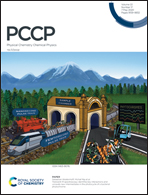Induced magnetic field in sp-hybridized carbon rings: analysis of double aromaticity and antiaromaticity in cyclo[2N]carbon allotropes†
Abstract
The induced magnetic field of C2N (N = 3–14) carbon rings was dissected to contributions from out-of-plane and in-plane π orbitals revealing two concurrent long range shielding or deshielding cones as a manifestation of the dual aromatic and antiaromatic character of C4n+2 and of C4n rings respectively. Aromaticity based on the magnetic criterion was evaluated with regard to the bonding pattern and geometrical characteristics that elucidate the influence of bond length and bond angle alteration on out-of-plane and in-plane magnetic responses. Ground state polyynic geometries of C4n+2 rings exhibit comparable shielding cones to annulenes, decreasing the magnetic response with regard to the ring size and similar πout and πin diatropicity. Transition state cumulenic rings display increased aromaticity expressed by a very strong constant magnetic response and augmented πout diatropicity with regard to πin. The variations of the induced magnetic field are explained on the basis of frontier orbital interactions through rotational excitations, which enable further rationalization of the aromatic/antiaromatic behavior.
![Graphical abstract: Induced magnetic field in sp-hybridized carbon rings: analysis of double aromaticity and antiaromaticity in cyclo[2N]carbon allotropes](/en/Image/Get?imageInfo.ImageType=GA&imageInfo.ImageIdentifier.ManuscriptID=D0CP01252A&imageInfo.ImageIdentifier.Year=2020)
- This article is part of the themed collection: 2020 PCCP HOT Articles


 Please wait while we load your content...
Please wait while we load your content...